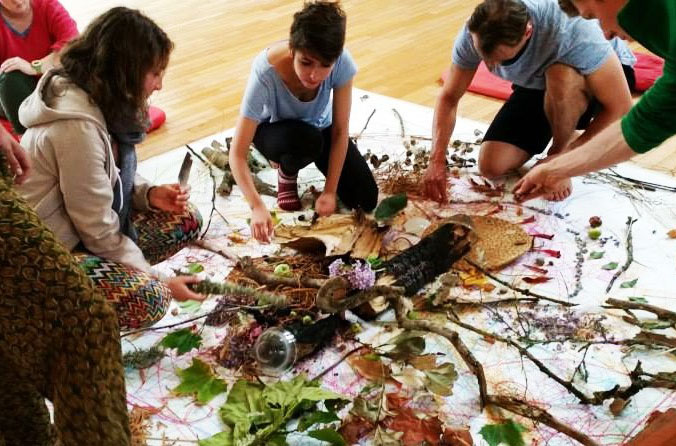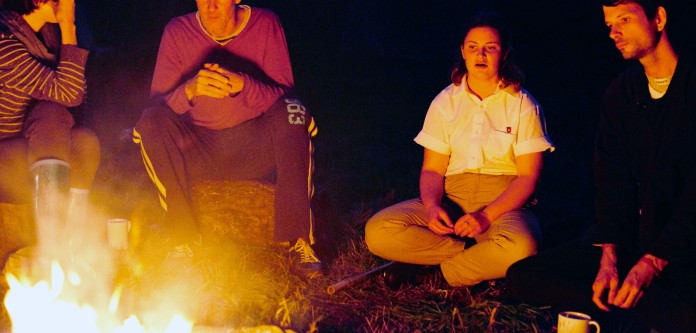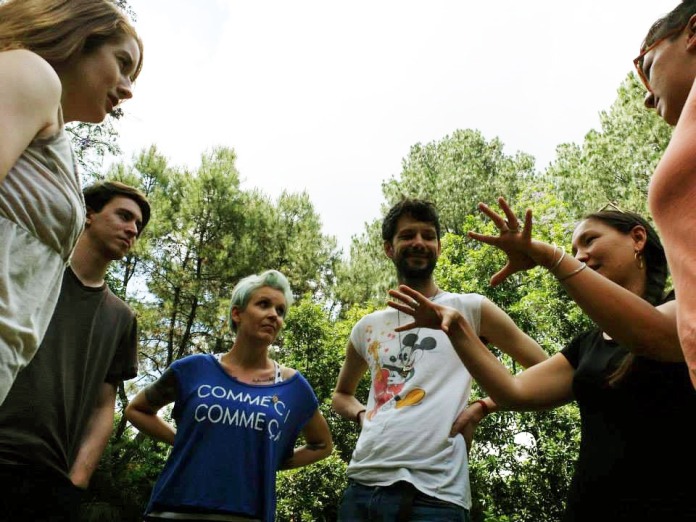The Ziji Gar
How the Ziji Gar was born
I am writing this on the train as I have just returned from the most wonderful few days at Dechen Chöling where myself, Lia Duggan, Simon Engelke, Simon Bertin, and Oli Wang met to discuss and continue to co-create together the Ziji Gar that will happen there from July 2nd to July 10th this year.
Gar is a Tibetan word that can be translated as camp or encampment. The idea is to transform the existing Summer Youth Retreat into a camp that arises and then dissolves, and that is based on the principles of meditation and enlightened society. In our time together at Dechen Choling, it became clear to us that the Ziji Gar is actually the confluence of four streams. In the first part of this series I will try to outline those streams.
Forest School Camps
The first idea for a Gar initially arose through conversations with Oli Wang about Forest School Camps. This is an educational charity in the UK, that has been run entirely by volunteers for over 70 years. Forest School Camps (often shortened to FSC) revolve around quite hardcore camping excursions with large groups of six to seventeen year olds looked after by adult staff. Participants in the camps often go on to become staff once they turn eighteen, and continue to staff throughout their adults lives – even with their own children or grandchildren in later years – thus there is a very strong sense of ongoing community.
The camps can last up to two weeks, sometimes as a ‘standing camp’ in a single location and sometimes as a ‘mobile camp,’ moving during that time on foot, bike, boat, or even through caves. Obviously a huge amount of energy goes into making sure the camp runs safely, that people stay dry (they are mostly in the UK so it rains a lot!), and that everyone is well fed from the strictly wood-fired and open-air kitchen. A core goal is to enable young people to ‘learn by doing,’ discover things for themselves and ‘reach their own decisions on small and not-so-small issues, individually or as members of a group.’
FSC has evolved into a rich secular tradition with well developed organisational structures. For example camps are divided vertically across the age groups into ‘clans’ with ‘clan chiefs’, as a way of sharing the responsibility for tasks such as cooking across the whole. It places great emphasis on woodcraft skills, a sense of connecting with nature, as well as group singing of folksong around the fire. Oli had seen meditation incorporated into some of the camps by staff, and this is why, in our discussions, she explained that she thought it could be powerful to bring more meditation into this kind of environment.
Summer Youth Retreat
Two summers ago I coordinated the Summer Youth Retreat at Dechen Chöling with Julia Bläuel from Vienna. This was a pivotal experience for me as I discovered how deeply I enjoyed to be in the role of coordinator. This was something which I had not considered at all until Julia invited me. Last year the Summer Youth Retreat was coordinated by my sister Jesse Watkins and Mederic Brochier. Although I didn’t attend, as at that point I need to take a quick respite from Ziji activities, I felt I was there in spirit via Jesse. The retreat changed a great deal from 2015 to 2016: whereas Julia and I had been looking after a group of 18 participants, now Jesse and Mederic were looking after 55. It had tripled in size in no small part because of the preparations for the Ziji Summit and the other youth related events that we were helping to make happen across Europe.

The Summer Youth Retreat began ten years ago. Each year the coordinators are asked to find the coordinators for the following year. When I worked with Julia we talked a lot about how we could create some kind of continuity in this process and how as young sangha in Europe we could look after the retreat longer term. Even with the tremendous support from Dechen Chöling, it was a huge ask each year for the coordinators to learn the job from scratch. When I spoke to Jesse after the Summer Youth Retreat in 2016, it became apparent to me that, although it had been a great success, it was much too much to hold in it’s present form and it had somewhat outgrown itself.
I will take this opportunity to also mention briefly Acharya Orhun Cercel in this context, as in recent years it has been his energy and enthusiasm that has helped the Summer Youth Retreat survive as a truly extraordinary program. It would make me very happy if even some of the wonderful qualities he brought into this programme we are now able to bring into our camp.
Sun Camp
The first people I reached out to in order to test the water for the Gar were the Sun Camp leadership. Sun Camp is an outdoor summer camp for people aged 10 to 16, that is connected to the Shambhala Tradition. That it worked with a similar age band to Forest School Camps had not escaped my attention, and similar to FSC there is a strong emphasis on the importance of being outdoors and a sense of working together to create the camp. In terms of the programme itself, Sun Camp ‘draws on military forms, such as wearing a uniform and raising flags, based on the idea that discipline and camaraderie can be used to conquer aggression and produce peace and cheerfulness.’ Each day there are one or two short formal meditation sessions, as well as lots of marching, a form that is considered meditation in action, and is easier to engage in for this age group than sitting meditation. The philosophy that underpins the programme is Buddhist, especially the emphasis on the inherent goodness of all beings.

Over the years I have met many Sun Camp graduates and I have consistently been amazed and impressed by their genuine sense of confidence in themselves and others. In Europe, at Dechen Choling, Sun Camp has been running for over 17 years, and through the course of that time a strong system of leadership has evolved in order to look after the program. This all meant that Sun Camp leadership were better placed than anyone to know about the feasibility of creating an annual (?) camp at Dechen Choling.
In our discussions, one clear decision we made very early on was that our camp must not infringe on the space that Sun Camp have been able to make for themselves. Quite literally we decided that we should not use the same field, and although, as ours was an embryonic project, there might be equipment we could rent or borrow from Sun Camp, we should keep this to a minimum. What they did have to offer however was the hard won wisdom accrued from experience and I already knew in my heart, that due to the scale and ambition of the transition I was hoping for, it would only be possible if one of the experienced Sun Camp leaders were equally excited by the project and wanted to help me bring this vision to fruition.
To this end I asked Lia Duggan from Dublin/Bruxelles if she would be my co-coordinator. I felt at that stage that she might be the only person with the necessary skills, background and enthusiasm to help me pull this off, and actually I still feel that. I decided that if she was up for it, then I would throw myself fully into the project. It was a tremendous relief when, after some months of careful deliberation, she accepted my invitation. I cannot now imagine doing this with anyone else.
The Ziji Summits
Two years ago I attended the Second Global Ziji Summit in Mexico. This was another clear way-marker in my journey of embarking on this kind of work. To put it simply, the Ziji Summit and the following retreat at Casa Werma completely blew my mind. In Mexico, Shastri Holly Gayley had the idea that the next Ziji Summit could be in Europe and despite being really just many small young sangha groups spread over many countries and a large mass of land, the delegates for Europe who attended the summit in Mexico accepted the challenge.
Attending my second Summit, this time the Ziji Global Summit in Berlin in September 2016, I was able to reflect deeply on what makes these gatherings so radical and powerful. The Ziji Collective is a very recent entity, much younger than the Summer Youth Retreat, Sun Camp, or FSC. As such there is a wonderful sense of experimentation and exploration, and I think the autonomy that this gives us as pioneering members of the Ziji Collective is one of the reasons I felt so quickly such a profound sense of interest and connection. Of course, although the Ziji Collective is very young, it is really the latest manifestation of many young sangha groups and collectives that have risen over the last thirty or forty years connected to the Shambhala community.

The Ziji Collective and the Summits are themselves the confluence of many streams. One of the principle origin stories for Ziji, like any story different each time it is told, speaks of a group of young Shambhala practitioners who wanted to join one of the Occupy protests a few years ago in the name of Shambhala, and taking with them a Shambhala banner. Their local centre didn’t allow this as traditionally Shambhala has not taken an overt political stance, and, as a reaction to this, later manifestations of Ziji have been imbued with a deep sense of the necessity for action. Indeed I personally see Ziji as occupying this intriguing space between developing deep inward realisation and using our power and capability as much as we can to look outward and try to help our world.
The Ziji Summits utilise many creative methods, such as Open Space Technology, Social Meditation, or Mudra Space Awareness, for cultivating effective discussion. In Mexico, Acharya Adam Lobel gave an excellent talk entitled ‘Triangle Circle Square’ in which he outlined different forms of social structure. In brief: triangle relates to hierarchy, square to governance and circle to the collective. The emphasis was that all of these can be useful depending on the context. I think the Ziji Summits have been especially fluid with these shapes, with a particularly refreshing emphasis on circle.
I have been deeply impressed at the efficacy of all these forms, and how combined in well thought through ways and most importantly held carefully by teachers and coordinators, they have allowed the wisdom of the group, both individual and collective, to be drawn out and harnessed. As we began to design the Gar, not only was it obvious that we would incorporate many of these practices, but more importantly, the forms we had learnt at the Summits immediately began to impact the very process of designing the Gar itself.
In part two I will investigate the ways that these four streams or traditions overlap and the various aspects of each that we have brought into the creation of the Gar.
[Editor’s Note: Part Two and Three of this article will be posted on the Ziji Gar Blog.]
Llew Watkins is an artist and writer, currently based in London. He is a member of the London Shambhala Meditation Centre.



